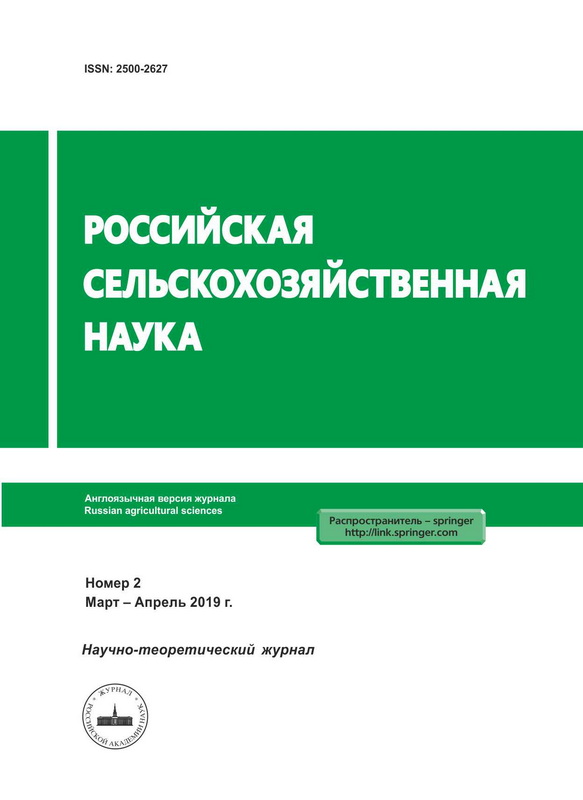Variability of rice haploids obtained in anther culture in vitro
- Authors: Ilyushko M.V.1, Romashova M.V.1
-
Affiliations:
- Federal Scientific Centre of Agrobiotechnology of the Far East named A.K. Chaika
- Issue: No 2 (2019)
- Pages: 11-14
- Section: Plant growing
- URL: https://journals.eco-vector.com/2500-2627/article/view/15543
- DOI: https://doi.org/10.31857/S2500-26272019211-14
- ID: 15543
Cite item
Full Text
Abstract
Morphological variability of haploid plants and doubled haploids of rice obtained on one callus line in anther culture in vitro was studied. The work was carried out on rice plants Oryza sativa L. subspecies japonica Kato varietу Cascade. Regenerant plants of one callus line obtained from one rice anther (four in total) were divided into two or three groups of 20-30 plants, depending on the sample size in order of their differentiation on callus and transplantation on the rooting medium. Two callus lines (15.1 and 18.1) formed half of the haploids, half of the doubled haploids, and two other callus lines (5.1 and 7.2) – numerous haploids. On callus lines with numerous haploids (5.1 and 7.2), as the regenant number increases, the size of plants decreases (plant height, number of flowers on the main panicle, number of panicles). On the lines 15.1 and 18.1 between groups of haploids and between groups of doubled haploids statistically significant differences absent. In breeding purposes for the induced doubling of the number of chromosomes in haploid regenerants with antitubulin substances such as colchicine, it is advisable to use plants that form on callus among the first. Between haploids of four callus lines and doubled haploids of two callus lines, statistically significant differences (at p=0.001) were revealed using the Hotelling's T2-criterion, calculated for the whole complex of biometric features. Haploids of different lines differed in three or four of them, doubled haploids on three of the five signs (length of panicle, productive bushiness and plant height). Varieties of interest to breeders may be improved by anther culture in vitro.
About the authors
M. V. Ilyushko
Federal Scientific Centre of Agrobiotechnology of the Far East named A.K. Chaika
Author for correspondence.
Email: ilyushkoiris@mail.ru
candidate of biological sciences
Russian Federation, Primorskiy kray, p. TimiryasevskiyM. V. Romashova
Federal Scientific Centre of Agrobiotechnology of the Far East named A.K. Chaika
Email: ilyushkoiris@mail.ru
candidate of agricultural sciences
Russian Federation, Primorskiy kray, p. TimiryasevskiyReferences
- Mishra R., Rao G.J.N. In-vitro androgenesis in rice: adventages, constraints and future prospects. // Rice Scienc. – 2016. – 23(2). – P.57-68.
- Germana M.A. Gametic embryogenesis and haploid technology as valuable support to plant breeding // Plant Cell Rep. – 2011. – V. 30. – P. 839-857.
- Datta S.K. Androgenic haploids: factors controlling development and its ap-plication in crop improvement. // Current Science. – 2005. – 89(11). – P.1870-1878.
- Dunwell J.M. Haploids in flowering plants: origins and exploitation. // Plant Biotechnol. J.– 2010. – 8. – P. 377- 424.
- Кучеренко Л.А., Харченко П.Н. Использование метода культуры тканей в селекции риса // Сельское хозяйство за рубежом. – 1975. – №11. – С. 20-21.
- Круглова Н.Н. Инновационная биотехнология андроклинной гаплоидии яровой мягкой пшеницы: эмбриологический подход // Аграрная Россия. – 2009. – № 1. – С. 34-38.
- Zagorska N.A., Shtereva L.A., Kruleva M.M. et al. Induced androgenesis in tomato (Lycopersicon esculentum Mill.). III. Characterization of the regenerants // Plant Cell Reports. – 2004. – V. 22. – P. 449-456.
- Alermanno L., Guiderdoni E. Increased doubled haploid plant regeneration from rice (Oryza sativa L.) anthers cultured on colchicine-supplemented media // Plant Cell Reports. – 1994. – V. 13. – P. 432-436.
- Rout P., Naik N., Ngangkham U. et al. Doubled Haploids generated through anther culture from an elite long duration rice hybrid, CRHR32: Method optimization and molecular characterization // Plant Biotechnology. – 2016. – V. 33. – P. 177-186.
- Mishra R., Rao G.J.N., Rao R.N. et al. Development and characterization of elite doubled haploid lines from two Indica rice hybrids. // Rice Science. – 2015. – 22(6). – P.290-299.
- Pauk J., Puolimatka M., Toth K.L., Monostori T. In vitro androgenesis of triticale in isolated microspore culture // Plant Cell, Tissue and Organ Culture. – 2000. – V. 61. – P. 221-229.
- Cistue L., Soriano M., Castillo A.M. et al. Production of doubled haploids in durum wheat (Triticum turgidum L.) through isolated microspore culture // Plant Cell Reports. – 2006. – V. 25. – P. 257-264.
- Kang T.-J., Yang M.-S., Deckard E. The effect of osmotic potential on anther culture in spring wheat (Triticum aestivum) // Plant Cell, Tissue and Organ Culture. – 2003. – V. 75. – P. 35-40.
- Kasha K.J., Hu T.C., Oro R. et al. Nuclear fusion leads to chromosome doubling during mannitol pretreatment of barley (Hordeum vulgare L.) microspores // Journal of Experimental Botany. – 2001. – V. 52. – №359 – P. 1227- 1238.
- Илюшко М.В., Скапцов М.В., Ромашова М.В. Содержание ядерной ДНК в регенерантах риса, полученных в культуре пыльников in vitro // Сельскохозяйственная биология. – 2018. – Т. 53. – № 3. – С. 531-538.
- Малецкий С.И., Юданова С.С., Малецкая Е.И. Эпигеномная и эпипластомная изменчивость у гаплоидных и дигаплоидных растений сахарной свеклы (Beta vulgaris L.) // Сельскохозяйственная биология. – 2015. – Т. 50. – С. 579-589.
- Сибикеева Ю.Е., Сибикеев С.Н. Влияние комбинаций чужеродных транслокаций на андрогенез in vitro у почти изогенных линий яровой мягкой пшеницы // Генетика. – 2014. – Т. 50. – №7. – С. 831-839.
- Heberle-Bors E. In vitro haploid formation from pollen: a critical review // Theor. Appl. Genet. – 1985. – V. 71. – P. 361-374.
- Илюшко М.В., Ромашова М.В. Регенерационная способность каллусных трансплантантов риса в культуре пыльников in vitro // Аграрный вестник Приморья. – 2018. – № 1 (9). – С. 5-8.
- Гончарова Ю.К. Использование метода культуры пыльников в селекции риса – Краснодар: ВНИИ риса, 2012. – 91 с.
- Хохлов С.С., Тырнов В.С., Гришина Е.В. и др. Гаплоидия и селекция – М.: Наука, 1976. – 121 с.
Supplementary files








